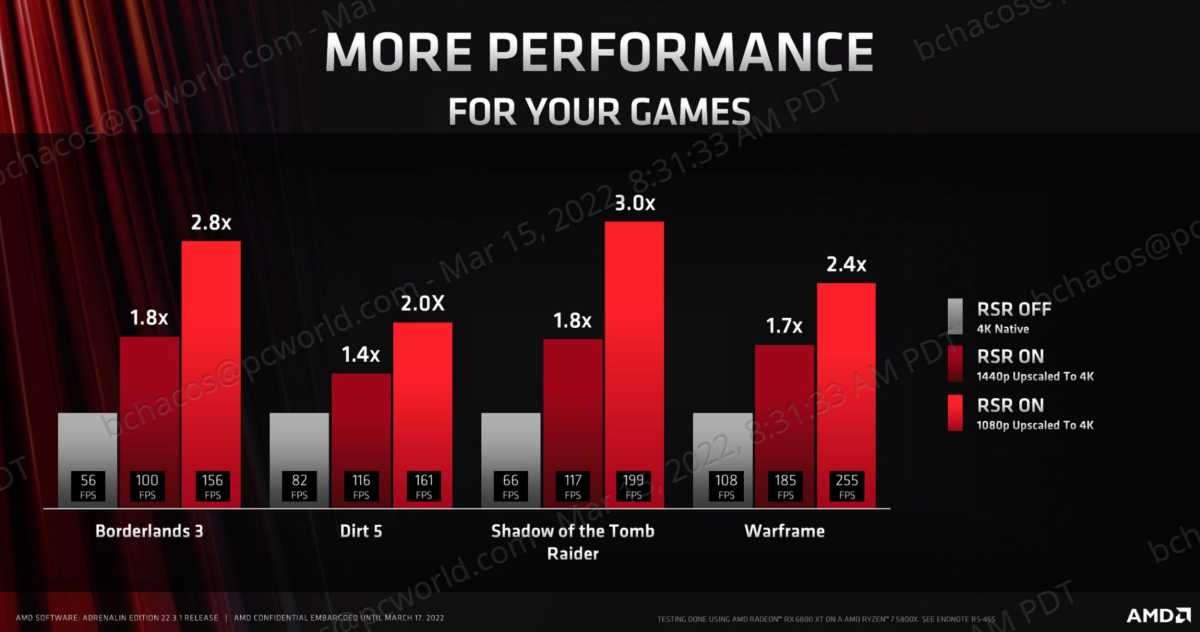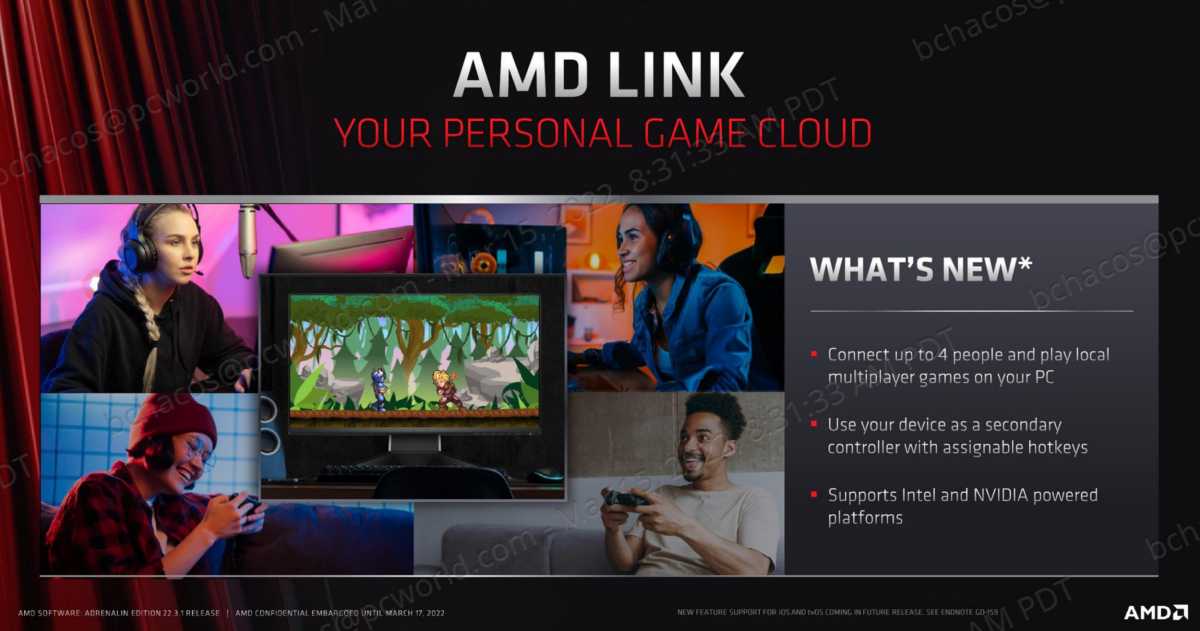AMD Adrenalin: Radeon Super Resolution arrives to speed up your games

 Image: Brad Chacos/IDG
Image: Brad Chacos/IDGCongratulations, Radeon graphics card owners. Most (and maybe all) of your PC games are about to run a whole lot faster now that the latest annual edition of AMD’s Adrenalin Edition software is here. The flagship feature is the debut of Radeon Super Resolution, first teased at CES in January, a new skill that brings the backbone of the company’s FidelityFX Super Resolution upscaling technology to thousands of games, not just the 80 or so titles that have announced formal FSR support.
Just as intriguingly, AMD is also teasing the next-gen FSR 2.0, with new software tricks that more mirror what Nvidia and Intel are trying to achieve with their rival upscaling technologies. There are some key differences, though. And there are a host of other improvements lurking within Adrenalin, from technical tweaks that drastically reduce the size of downloaded drivers to the ability to play games with your pals, regardless of the rigs they’re running. Let’s dig in.
Radeon Super Resolution
Radeon Super Resolution is the star of the show, of course. Both AMD’s FSR and Nvidia’s rival DLSS require game developers to integrate the upscaling technologies into their games before gamers can take advantage of their potential performance benefits. Radeon Super Resolution basically lets Radeon owners flip on that upscaling at a driver level, bringing FSR-like goodness to hundreds and thousands of games.
Let’s take a quick step back. RSR, like FSR, lets a graphics card internally render games at a lower resolution, then performs software tricks to upscale that image to the higher chosen resolution of your monitor. Because your GPU is rendering a game at, say, 1080p or 1440p resolution before upscaling it to the much more strenuous 4K resolution, you’ll see a big performance boost. It can potentially make previously unplayable games playable on your GPU, and greatly increasing the responsiveness of the games you’re playing.

AMD
AMD
AMD
Flipping Radeon Super Resolution on couldn’t be easier. Simply head into the Gaming > Graphics tab in AMD Adrenalin Edition and enable RSR to turn it on globally if desired, or head into the per-game options to only enable it with select titles. The first time you do, a wizard will appear that explains how to use it.
Basically, you only need to dive into the settings menu of a game with RSR active and select a lower resolution with the same aspect ratio of your monitor in its graphics settings. If you activate Radeon Super Resolution on a 4K monitor, for example, selecting either 1800p, 1440p, or 1080p as the in-game resolution will tell the game to render internally at that lower resolution, increasing performance, but the final image will render at full 4K with an assist from RSR’s upscaling magic. The lower you go resolution-wise, the faster your performance will be, but it could also introduce more visual irregularities, like blurriness.
You’ll need to play around a little bit to figure out a resolution that looks good by your eye while still providing a solid speed boost. Keith May took a deeper look at Radeon Super Resolution for PCWorld’s YouTube channel in the video posted above. He shows the speed gains and image quality impact of using RSR at a variety of resolutions in several games, so you can see its chops with your own eyes. Spoiler alert: He found that using Radeon Super Resolution to upscale games from 1440p to 4K provided a noticeable performance uplift with very little impact on the image quality of games while in motion.
Being able to turn Radeon Super Resolution on in thousands of games across your entire library is a benefit that can’t be understated. Flipping it on to get faster performance in strenuous games could let you bump up image quality, activate strenuous ray tracing effects, or hit the hallowed 60fps gold standard in games where it wasn’t possible before.

AMD
AMD
AMD
There are some caveats. This initial release of Radeon Super Resolution is limited to desktop Radeon RX 5000- and RX 6000-series graphics cards—older models or laptop GPUs aren’t yet supported, though AMD aims to roll out compatibility for Ryzen 6000 laptop processors with integrated Radeon graphics next quarter. You’ll also need to set your games to exclusive full screen mode, though if a game only offers borderless full screen mode, you can get around it by changing your desktop resolution in Windows settings to one notch lower than your monitor’s native resolution. That will kick RSR into action.
Finally, if a game offers native FidelityFX Super Resolution support, stick to that over this driver-level RSR tool. As we explained in our original coverage:
“FSR works its magic midway through the rendering process, so it handles all its upscaling and sharpening before visual extras like film grain, chromatic aberration, and the game’s heads-up display get added in. That keeps those elements looking as the developers intended. Since Radeon Super Resolution kicks in at the very end of the graphics rendering pipeline, that’s no longer the case. That tweak could mean that the heads-up display and other text could wind up looking slightly off in some cases.”
Speaking of FSR…
FidelityFX Super Resolution 2.0
It isn’t part of the Adrenalin Edition upgrade, but AMD also took the time to tease the next generation of FidelityFX Super Resolution to the press.
The first iteration of FSR launched last summer and rapidly become the fastest adopted software technology in AMD’s history, the company claims, thanks to its vendor-agnostic hardware support (yes, it runs on Nvidia GPUs too) and easy inclusion in games. It’s a simpler technology than the upscaling deployed by rivals like Nvidia DLSS, Unreal Engine 5, and Intel’s upcoming XeSS however, relying on spatial upscaling of a rendered frame alone. Those rivals use temporal motion vectors across several frames to lessen the potential visual impact of upscaling. FidelityFX 2.0 will as well. Good!
AMD didn’t divulge too many technical details, saying only that the final picture looks better than FSR 1.0 and similar or better than native image quality. But crucially, unlike DLSS and XeSS, FSR 2.0 won’t require dedicated machine learning hardware (such as the tensor cores found in GeForce RTX GPUs). Instead, it should run on traditional graphics cards, including ones from AMD, Nvidia, and Intel alike, just like the first-gen FSR.
That’s mighty intriguing stuff indeed. AMD plans to release more technical details during its “Next-generation image upscaling for games” presentation at the Game Developers Conference on March 23. We’re very keen to hear more.
A shot of Adrenalin
The rest of Adrenalin’s improvements don’t have the star power of Radeon Super Resolution, but AMD’s software is getting some quality-of-life upgrades that look very welcome indeed.
It starts with the downloads themselves. If you use Adrenalin to update your Radeon drivers (as you should be), the software will now compare your installed version against what’s new, then install only the bits and blobs that have changed. That should mean faster downloads with much smaller file sizes, a flat-out wonderful improvement in an era when every GPU driver clocks in around 500GB in size. Windows itself recently changed to a similar process and it’s resulted in much less overhead.

AMD
AMD
AMD
Another key change? The AMD Link feature that lets you play games with your friends in Steam Remote Play-like fashion now works with any PC. You still need a Radeon-based system to kick it off, of course—it’s still an AMD driver feature—but now the share links will work on systems with Nvidia and Intel inside, too. The tool only worked on AMD-based system in the past, which was a gnarly and frustrating drawback to an otherwise compelling feature.
Adrenalin will also now pop up a toast notification when you launch a game, showing which Radeon technologies are active or disabled, and now you can use the fantastic Radeon Image Sharpening tool to crisp up your media, office, and web apps too—not just games.
All in all, while this annual iteration doesn’t pack in quite as many new features as some prior Adrenalin updates, that speaks to just how far AMD has come in its software efforts over the last several years. Radeon drivers used to be notoriously flakey, but through tireless effort and a serious commitment to listening to its community in recent times, AMD Software is now just as polished and compelling as Nvidia’s rival GeForce Experience—better, in many ways. And Radeon Super Resolution is a seriously powerful new tool in AMD’s arsenal, one that can instantly speed up your Radeon GPU in an era where new graphics cards are a terrible burden to try to find. Rock on.
Author: Brad Chacos, Executive editor

Brad Chacos spends his days digging through desktop PCs and tweeting too much. He specializes in graphics cards and gaming, but covers everything from security to Windows tips and all manner of PC hardware.
Recent stories by Brad Chacos:
Nvidia GeForce RTX 4080 Super review: The 4K graphics card you wantNew Arc drivers provide huge DX11 performance boost for Intel GPUsAudio Radar gives hearing impaired gamers a fair shot






